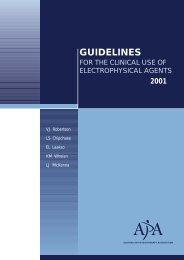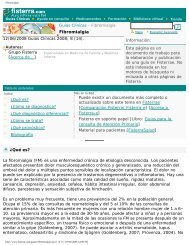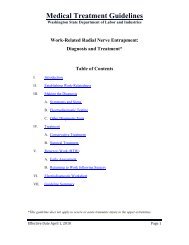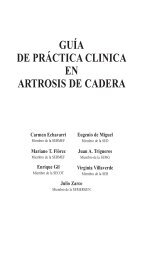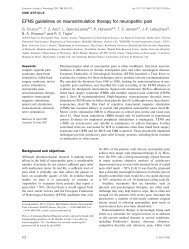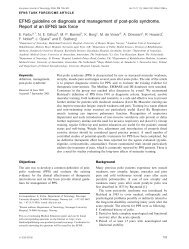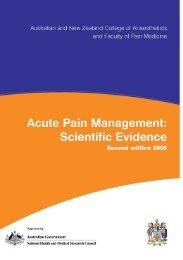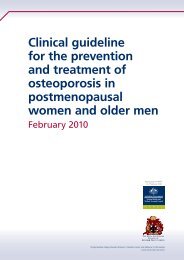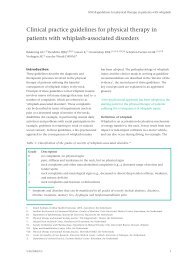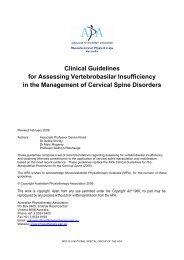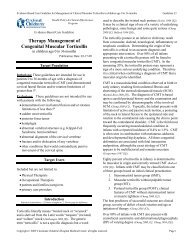Practice Parameter and Literature Review of the Usefulness of ...
Practice Parameter and Literature Review of the Usefulness of ...
Practice Parameter and Literature Review of the Usefulness of ...
You also want an ePaper? Increase the reach of your titles
YUMPU automatically turns print PDFs into web optimized ePapers that Google loves.
<strong>Practice</strong> <strong>Parameter</strong>: Carpal Tunnel Syndrome(Table 2).The AAEM recommends that studies which compare <strong>the</strong>sensitivity <strong>and</strong> specificity studies <strong>of</strong> NCSs <strong>and</strong> needle EMGto <strong>the</strong> sensitivity <strong>and</strong> specificity <strong>of</strong> o<strong>the</strong>r tests proposed for<strong>the</strong> diagnosis <strong>of</strong> CTS use <strong>the</strong> clinical diagnosis <strong>of</strong> probableCTS as defined in Table 2. These alternative diagnosticstudies include <strong>the</strong> following: quantitative cutaneoussensory testing <strong>of</strong> perception threshold for vibration, 2-pointdiscrimination, touch, warmth, cold, <strong>and</strong> electriccurrent; 21,22,120,153,160,168,247 h<strong>and</strong> symptom diagrams; 122,123,124magnetic resonance imaging <strong>and</strong> computed tomographicstudies <strong>of</strong> <strong>the</strong> carpal tunnel; 16,17,99,169 <strong>the</strong>rmography; 100,170,240wrist ratio; 90 provocation <strong>of</strong> symptoms by ultrasound; 172 <strong>and</strong>carpal tunnel pressure measurements. 78,212Both <strong>the</strong> first <strong>and</strong> second AAEM CTS <strong>Literature</strong> <strong>Review</strong>srecommended that outcome studies should be performed toassess <strong>the</strong> harms, benefits, <strong>and</strong> costs <strong>of</strong> performing NCSs<strong>and</strong> needle EMG in patients with symptoms suggestive <strong>of</strong>CTS.The AAEM recommends that future outcome studies <strong>of</strong>treatment <strong>of</strong> CTS use <strong>the</strong> clinical diagnoses <strong>of</strong> definite CTS(as defined in Table 2) with EDX studies <strong>of</strong> high sensitivity<strong>and</strong> specificity for <strong>the</strong> diagnosis <strong>of</strong> CTS performed by aspecially trained physician, i.e., median mixed nerve palmarstudies <strong>and</strong>/or comparison <strong>of</strong> median to ulnar <strong>and</strong>/or radialsensory NCS in <strong>the</strong> same h<strong>and</strong>.The AAEM CTS Task Force has addressed future researchprinciples over future research topics (except for outcomestudies) because <strong>the</strong> Task Force concluded that futureresearch studies need to meet <strong>the</strong>se principles (1) to providereliable <strong>and</strong> reproducible data to evaluate <strong>the</strong> usefulness <strong>of</strong>EDX studies to confirm <strong>the</strong> clinical diagnosis <strong>of</strong> CTS <strong>and</strong>(2) permit comparison <strong>of</strong> <strong>the</strong> relative utility <strong>of</strong> differentEDX studies for that purpose.It is recommended that <strong>the</strong> AAEM review this report every5 years <strong>and</strong> update <strong>the</strong> report as necessary.DISCUSSIONThis report includes 2 recommendations in addition to thosein <strong>the</strong> 1993 CTS <strong>Literature</strong> <strong>Review</strong> to improve futureclinical research studies <strong>of</strong> <strong>the</strong> usefulness <strong>of</strong> EDX studies toconfirm <strong>the</strong> clinical diagnosis <strong>of</strong> CTS.1. This report provides a new consensus based set <strong>of</strong>inclusion <strong>and</strong> exclusion criteria for <strong>the</strong> clinicaldiagnosis <strong>of</strong> CTS according to <strong>the</strong> certainty <strong>of</strong> <strong>the</strong>diagnosis: possible CTS, probable CTS, <strong>and</strong>definite CTS (Table 2). We recommend <strong>the</strong> criteriafor <strong>the</strong> diagnosis <strong>of</strong> probable CTS be used infuture studies <strong>of</strong> EDX tests to reduce <strong>the</strong> possibility<strong>of</strong> selection bias, to provide a more uniformpopulation <strong>of</strong> CTS patients, <strong>and</strong> to provide a validscientific basis for comparison <strong>of</strong> <strong>the</strong> results <strong>of</strong>future studies from different laboratories. Thissuggestion is a refinement on <strong>the</strong> originalrecommendation made in <strong>the</strong> 1993 CTS <strong>Literature</strong><strong>Review</strong>.2. Sackett <strong>and</strong> colleagues 217 <strong>and</strong> o<strong>the</strong>rs haverecommended that clinical research studies <strong>of</strong>diagnostic tests (including EDX studies) beperformed with <strong>the</strong> physician performing <strong>and</strong>interpreting <strong>the</strong> diagnostic tests blinded to <strong>the</strong>diagnosis <strong>of</strong> <strong>the</strong> subject with <strong>the</strong> goal <strong>of</strong>eliminating observer bias. There is a solid body <strong>of</strong>clinical evidence <strong>and</strong> experience which indicatesthat NCSs are useful to confirm <strong>the</strong> diagnosis <strong>of</strong>CTS, a body <strong>of</strong> evidence similar in weight to <strong>the</strong>clinical evidence that radiographs are useful toidentify fractures <strong>of</strong> <strong>the</strong> limb bones <strong>and</strong>electrocardiograms are useful to identifymyocardial ischemia <strong>and</strong> infarction. Never<strong>the</strong>less,it is worth performing future evaluations <strong>of</strong> EDXstudies in CTS with <strong>the</strong> examiner blinded to <strong>the</strong>clinical diagnosis <strong>of</strong> <strong>the</strong> subject as <strong>the</strong> next step toestablishing <strong>the</strong> validity <strong>of</strong> <strong>the</strong>se conclusionsbeyond a reasonable doubt. In fact, some clinicalinvestigators have already begun to performevaluations <strong>of</strong> NCSs in CTS in a blinded fashion(Salerno <strong>and</strong> colleagues 218,219 <strong>and</strong> Werner <strong>and</strong>colleagues 263 ).In <strong>the</strong> 1993 AAEM CTS <strong>Literature</strong> <strong>Review</strong>, it wasrecommended that an outcome study be performed to assess<strong>the</strong> harms, benefits, <strong>and</strong> costs <strong>of</strong> performing NCSs <strong>and</strong>needle EMG in patients with symptoms suggestive <strong>of</strong> CTS.In 1994, Boniface <strong>and</strong> colleagues 20 published a prospectivestudy from Engl<strong>and</strong> which demonstrated that NCS/EMGstudies were useful <strong>and</strong> cost effective in management <strong>of</strong>patients suspected <strong>of</strong> CTS. 20 In addition, <strong>the</strong> AAEM hasencouraged additional outcome studies including <strong>the</strong>publication <strong>of</strong> guidelines for outcome studies inneuromuscular diseases including CTS. 108 The AAEMResearch <strong>and</strong> Education Foundation has recently funded aprospective outcome study <strong>of</strong> 400 patients to evaluate <strong>the</strong>usefulness <strong>of</strong> EDX studies in <strong>the</strong> evaluation <strong>and</strong>management <strong>of</strong> patients with symptoms suggestive <strong>of</strong> CTS.It is recommended that outcome studies continue to be apriority for future clinical research in <strong>the</strong> diagnosis <strong>and</strong>management <strong>of</strong> CTS <strong>and</strong> o<strong>the</strong>r neuromuscular diseases.INTERFACE WITH AAEM GUIDELINESIn 1999, <strong>the</strong> AAEM republished guidelines based uponexpert opinion <strong>and</strong> first published in 1992 for <strong>the</strong> evaluation<strong>of</strong> CTS patients. 2,4 The AAEM Guidelines recommend <strong>the</strong>following EDX studies: (1) median sensory or mixed NCSto include determination <strong>of</strong> (a) <strong>the</strong> amplitude <strong>and</strong> (b) peaklatency or onset latency or CV <strong>of</strong> <strong>the</strong> segment <strong>of</strong> <strong>the</strong> mediannerve passing through <strong>the</strong> carpal tunnel; (2) median motorMuscle & Nerve Supplement X 2002 S957



